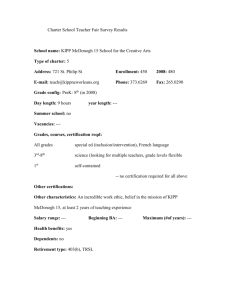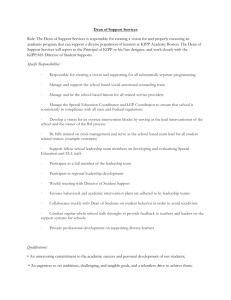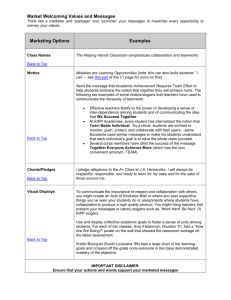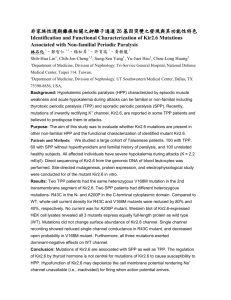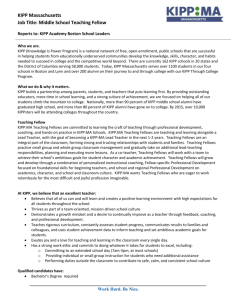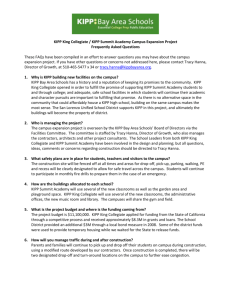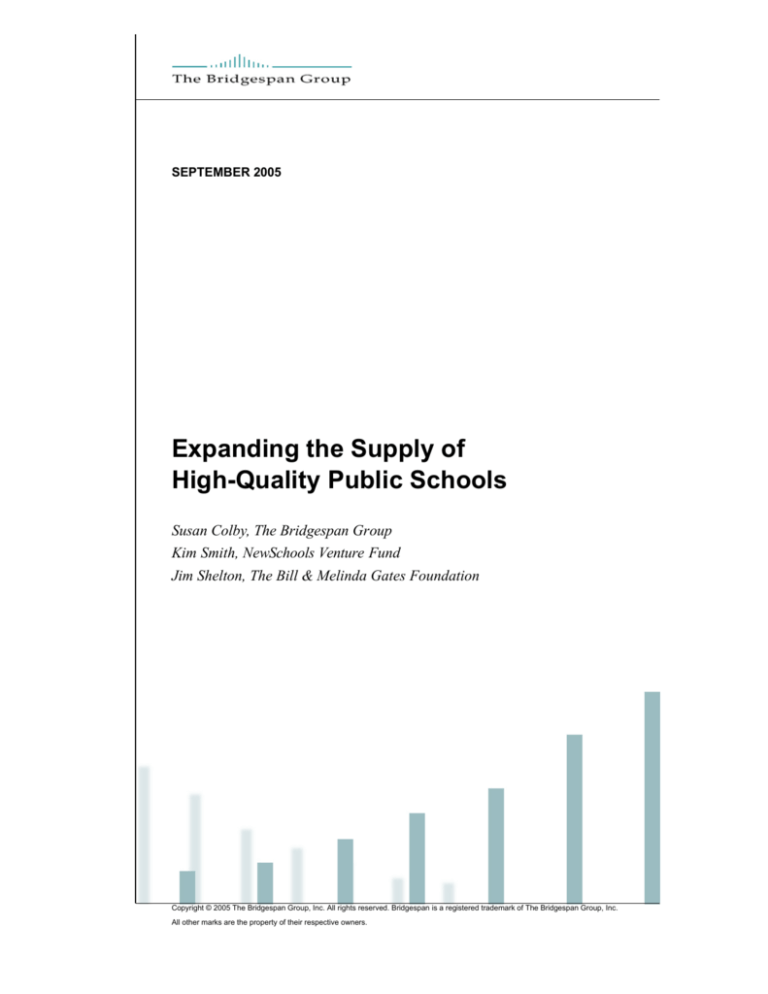
SEPTEMBER 2005
Expanding the Supply of
High-Quality Public Schools
Susan Colby, The Bridgespan Group
Kim Smith, NewSchools Venture Fund
Jim Shelton, The Bill & Melinda Gates Foundation
Copyright © 2005 The Bridgespan Group, Inc. All rights reserved. Bridgespan is a registered trademark of The Bridgespan Group, Inc.
All other marks are the property of their respective owners.
2
Over the past decade, the supply of both new schools and redesigned district
schools has mushroomed. Propelled by forces ranging from charter-school, state,
and federal accountability legislation, to strong demand from parents and students,
to mounting public opinion pressing for reform, educators and education
entrepreneurs have poured their energies into developing innovative solutions to
improve America’s schools.
Despite the growing momentum, however, there are not yet nearly enough good
schools to go around; nor does the capacity exist to turn around all the schools
that are currently failing. Many educators remain skeptical of the staying power of
current reform initiatives. The news media continue to be filled with reports about
schools that are not living up to their promise—many high-profile success stories
notwithstanding.
The fact that so many of the successful new and redesigned schools have been
one-off, isolated experiments magnifies the confusion. Everyone knows that certain
schools work: but exactly what is working or how the success of one school can be
replicated in other contexts is much less clear.
The NewSchools Venture Fund, the Bridgespan Group, and the Bill & Melinda
Gates Foundation have been working with a wide range of school development
organizations across the country to increase the number of high-performing
schools. In the process, we have identified two levers that appear to play a
critically important role in determining how quickly and consistently successful
schools and design models can be replicated. One is the degree of managerial
responsibility, support, and control the organization chooses to exercise. The other
is the specificity of its school design. The choices an organization’s leadership
makes about each of these levers will affect how quickly its model can be
replicated, the human and financial capital it will require, and the likelihood of
achieving consistent high-quality outcomes.
In general, the greater the degree of management support and design specificity a
school development organization provides, the better the odds are that it will be
able to replicate high-quality results in new locations. At the same time, such
models are likely to grow slowly and, in many cases, their cost structures are
unlikely to be replicable at a broad systems level. In contrast, models that are more
3
loosely managed and leave more room to others for interpretation can be
replicated quickly, but the odds that the quality of the results will suffer are also
higher.
Given the urgent need for more high-quality schools, there is room for many
approaches to increasing the supply of new and redesigned schools. By the same
token, however, it is crucial that school development organizations understand the
tradeoffs that are inherent in each approach, so that the decisions they make
about management responsibility and design specificity will be aligned with the
impact they are trying to achieve as well as with their replication strategy.
Mapping the School Development Landscape
The universe of school developers is highly diverse.1 For the past 30 years, many
talented educators, leaders, and funders have taken up the call to fix America’s
schools, bringing with them a variety of creative and often research-based
solutions. Early on, many of these efforts focused on pieces of the problem:
offering rigorous academic enrichment to remedial students, for example; or
expanding college preparatory course offerings; or providing students with caring
adult mentors. But while many of these programs achieved good results, more
often than not the results occurred in some contexts for some students.
Consequently, researchers have increasingly concluded that if lasting change is to
occur for all children, particularly the most disadvantaged, the entire system will
have to change, with effective schools becoming the norm in every district without
the cost—and delay—of creating new models each and every time.
New American Schools, the privately funded, nonprofit corporation established in
1991 in conjunction with President Bush’s America 2000 Initiative, was one of the
pioneers in taking a comprehensive approach to reforming schools and, in some
1
As used in this paper, the term “school developer” refers to third-party organizations involved in
the transformation and/or creation of public schools.
4
cases, school districts. NAS was guided by the principle that all high-quality
schools possess a unifying design that provides a consistent and coherent
instructional program to all students and allows all staff to work to the best of their
abilities. As NAS and others have learned, however, conducting effective wholeschool reform is vastly more complicated than designing a targeted program. All
the components of the school—from its curriculum to its governance structure—are
in play. Developing an integrated model that will work in multiple contexts is an
even more daunting task. Nevertheless, growing numbers of school reform
organizations have taken up the challenge.
Broadly speaking, these organizations approach their work in one of two ways: by
consulting to new or existing schools or school and district leaders; or by operating
new or redesigned schools themselves. Developers in the first group (technical
assistance, or TA, providers) provide training, a research-based model for the
design of the school, and coaching to the schools and leaders in their networks,
but they neither “own” nor operate schools themselves. Those in the second group
(school managers) represent a more recent addition to the ranks of school
reformers. These organizations create, manage, and sometimes own new start-up
schools, either within a district or outside of it. Unlike TA providers, which can
expand the number of schools with which they work by adding part-time or
consulting staff, school managers grow by replicating entire schools with their
supporting infrastructure.
THE SPECTRUM OF MANAGEMENT RESPONSIBILITY, SUPPORT,
AND CONTROL
Based on this fundamental difference in approach, developers can be arrayed
along a spectrum of management responsibility, support, and control, running from
loose to tight. TA providers tend to be clustered at the left end of the spectrum, in
the voluntary association camp, organizing the schools in their networks in loose
federations, with little operational oversight. School managers, on the other hand,
tend to fall at the right end of the spectrum, operating the facilities, hiring and
managing the staff, and even holding the schools’ charters or performance
contracts.
5
Between these two extremes is a third group of developers that employ a variety of
forms, ranging from informal, quality-assurance mechanisms to formal “franchise
agreements” and standards, to engage with the schools in their networks.
Developers that fall into this intermediate realm, which we call deep engagement,
can be structured either as partial managers or as deep TA providers. (Exhibit 1
illustrates this spectrum.)
Exhibit 1: Spectrum of management responsibility, support, and control
Loose
Voluntary
association
Tight
Deep
engagement
True
ownership
A variety of factors influence where along the spectrum school developers choose
to locate themselves, including their impact goals and program model, their
organizational capabilities and culture, and the scale and complexity of their
operations. Ensuring quality as new schools open depends not only on having a
firm grasp of the model’s critical elements, but also on having access to the
requisite people and funding. Consequently, the choices school developers make
may also be a function of funders’ interests at a given time. At present, for
example, significantly more public sources are available to fund consulting and
coaching models than exist to cover the capital and scaling costs of starting
systems of new schools.
THE SPECTRUM OF DESIGN SPECIFICITY
School-development organizations can be further mapped along a second
dimension: the specificity of their school design. This dimension reflects the degree
to which a particular developer’s model is codified and standardized, with options
falling along a loose-tight spectrum from broad design principles to a fully specified
design. (Exhibit 2 illustrates this spectrum.)
6
Exhibit 2: Spectrum of design specificity
Loose
Tight
Broad
design
principles
Fully
specified
design
Once again, the degree of specificity a given school developer chooses is likely to
be influenced by a number of considerations, including its leadership’s values and
beliefs about the nature of schooling and teaching and what will motivate others to
become involved in their efforts. For example, some school developers believe that
each new school has to be customized and co-created with the local community at
the grass-roots level; while others believe, equally strongly, that research-based
models can work in many contexts as long as they are adjusted to accommodate
local cultural and community needs and desires.
When these two organizational levers are arrayed along the x- and y-axes of a
matrix, the result is a grid with six cells which we have named on the basis of the
prototypical organizations that occupy them. Although many school developers will
move about within this grid during their organizational lifetimes, most can be
located in one or another of these cells. We recognize that these names may
change as the field evolves over time; what is important is not the name of a
particular category per se, but rather what it implies for a school developer’s ability
to grow and maintain the quality of its results over time. (Exhibit 3 illustrates this
matrix. The Appendix contains a definition of each category accompanied by an
example.)
7
Exhibit 3: Mapping the school development landscape
Tight
Design
Team
Franchise
EMO/CMO
Association
Partner
Portfolio
Manager
Design
specificity
Loose
Loose
Tight
Management responsibility,
support, and control
Managing the Levers of Growth
The degree of management responsibility a school developer exercises and the
specificity of its school design have implications for its growth trajectory.
Organizations that maintain a high degree of management responsibility generally
grow more slowly than those that give affiliates more autonomy. For that very
reason, however, the latter also may have more difficulty achieving consistent
results, especially over time. Similarly, a highly flexible school design can enable
faster growth, but it is also subject to less consistency, especially if the founding
leaders or teams move on. In contrast, more highly specified designs can have
mixed effects: the existence of a prescribed model that others are able to replicate
can speed up growth; but the need to monitor the fidelity of its implementation may
slow the pace down or drive the cost up. Whatever the consequences, however,
greater design specificity is likely to increase the consistency of the results.
8
Finding the right level of managerial responsibility and design specificity is a
balancing act, which depends not only on the school developer’s skills,
capabilities, assets, and relationships, but also on the site-level leaders and
community in which reform is occurring. (Oakland, Chicago, Los Angeles, and New
York are all urban school districts, for example, but each city’s political context is
quite different.) It is also a learning process, which often leads to different
decisions as an organization ages or grows.
For example, school developers that start out overseeing new sites quite loosely
may decide to tighten the reins as they add more sites in order to maintain
consistent results. The National Council of La Raza (NCLR) began its Charter
School Development Initiative (CSDI) in 2000 in response to significant demand
from community-based affiliates and persistent failures on the part of the public
schools to close the education gap between Hispanics and other groups. CSDI
provided a range of training programs and technical assistance to its initial
grantees, but it did not require them to adopt a specific school design. Now, with
achievement of its initial goal of 50 affiliate-based schools in sight, NCLR is shifting
toward a tighter design model and a deeper level of management support,
including performance evaluations of CSDI mid-managers linked directly to
improvements in student achievement. Alternatively, if developers that have
successfully created small numbers of high-performing schools want to increase
the pace at which they can provide better outcomes for more kids, they will have to
identify—and focus on—the handful of elements in their school-design and
management models that are most critical to achieving results.
To illustrate how the organizational levers of responsibility and design can be used
to promote more consistent, higher-quality replication, consider three examples.
BAYCES: FROM ASSOCIATION TO PARTNER
The Bay Area Coalition of Equitable Schools (BayCES) was founded in 1991 to
create and sustain networks of high-achieving and equitable small schools.
Working with the educational principles promulgated by Brown University professor
Ted Sizer in his book Horace’s Compromise, but with increased focus on the issue
9
of equity, BayCES originally was located in the association (or lower left) corner of
the matrix. Its leaders were strong believers in the value of local ownership and felt
that each community had to adapt its school design to meet the needs of its own
constituency of students, teachers, parents, and neighborhoods and, ultimately,
help schools achieve high and equitable outcomes for all of their students. As a
result, BayCES focused on developing a customized design at each site through a
collaborative process of listening, playing back what they heard, mobilizing the
school community toward short-term, achievable goals, and learning from the
results. Persuaded that reforms could be sustained by changing the norms and
expectations of communities and classroom teachers, BayCES’s leadership did not
attempt to exercise management control at the school or district level. The only
absolutes were its guiding principles, which were broadly directional rather than
prescriptive (for example, “teaching and learning should be personalized to the
maximum feasible extent,” and “the school should demonstrate non-discriminatory
and inclusive policies, practices, and pedagogies”).
As BayCES evolved, however, its leadership increasingly realized that the district
bureaucracy was itself a major impediment to classroom-level change. It therefore
chose to work with the leaders of its focus districts to create a policy environment
conducive to its work at the school level (for example, creating a new policy in the
Oakland Unified School District to promote and support the development of small
schools). To gain the requisite degree of control, BayCES took an unusual and
powerful approach: rather than try to operate the schools, which officially reported
to the district, BayCES developed reciprocal relationships with grassroots groups
like the Oakland Community Organization to mobilize thousands of parent-activists
to interrupt “business as usual” at the district and to protect BayCES’s work—and
its benefits to their children. This overwhelming community support (together with
its credible, professional staff of former teachers, research-based approach,
understanding of Oakland politics, and flexible funding) gave BayCES a degree of
influence over the district that moved it significantly along the axis of management
responsibility, support, and control.
Today BayCES is a deeply -engaged partner, playing an integral role at the school,
district, and community levels: supporting new small schools, building district
capacity and ensuring supportive policies, and mobilizing sustained community
10
demand for better schools. The tradeoff BayCES has had to make is in the pace of
growth. Under its earlier coaching model, BayCES was able to grow rapidly and
flexibly by extending its services to schools throughout the Northern California
region. The only major impediment to its growth was the availability of skilled
coaching staff—a major constraint, but not as binding as having to be able to work
at the district, school, and community level. Now, because so much of its ability to
achieve impact depends on its deep local knowledge, district relationships, and
active political constituency, as well as the availability of skilled coaching staff,
BayCES cannot replicate its model easily in new locations.
BayCES anticipates that the process of building a lasting local coalition could take
many years and that its impact will require work at multiple levels: the community,
the school, and the district. The work in the community, in fact, is what will hold
schools and districts accountable—a key way in which BayCES exerts
management control. Looking ahead, BayCES plans to grow by deepening its
work with its current partners in Oakland, Emeryville, and Berkeley and truly
transforming those districts and communities into places where the community
demands and expects high quality education for all of its students.
KIPP: FROM FRANCHISE TO MANAGEMENT ORGANIZATION
KIPP, which stands for the Knowledge is Power Program, got its start in 1994 when
Mike Feinberg and Dave Levin, two Teach for America graduates, launched a
program for 5th graders at Garcia Elementary, an inner-city Houston public school.
On the basis of their students’ accelerated results, the program quickly evolved
into one of Houston’s first charter schools and expanded to New York, with the
opening of the KIPP Academy in the South Bronx in 1995. As word of the schools’
success spread (especially after a 60 Minutes profile in 1999), requests to replicate
the program multiplied; and in 2000, Feinberg and Levin partnered with Gap, Inc.
founders Doris and Don Fisher to create the KIPP Foundation to support the
school model’s replication in new sites.
Rather than try to stipulate every aspect of a school’s design, the Foundation
focused on the element it believed was paramount: the school’s culture. Culture
11
was defined through a set of values, norms, and practices, which were spelled out
in the “five pillars” of the KIPP model. For example, every KIPP school has to have
high, clearly-defined, measurable expectations for its students’ academic
performance and conduct. Norms such as parent and student contracts supported
this culture of achievement, which was reinforced by a range of formal and
informal rewards and consequences as well as a “no-excuses” mindset.
The KIPP Foundation was similarly judicious about emphasizing a small number of
essential management levers, of which leadership was by far the most important.
KIPP uses a rigorous selection process to identify prospective school leaders who
are both high achievers themselves and committed to improving the educational
achievements of their students. The Foundation then hones these qualities and
ensures the consistency of its vision and values through a year-long leadership
program, which includes a six-week program on instructional, operational, and
organizational leadership, a two-month residency in existing KIPP schools, and six
months of school start-up work, supported by KIPP Foundation teams. In addition,
the KIPP schools’ charters are generally held by a local KIPP school governing
board, which is accountable for its performance and compliance with local charter
laws as well as local community support.
Adopting this “franchise” model, which controls certain elements of replication (the
culture of KIPP schools is so strong that you know you are in one when you walk in
the door) and requires local partners to fundraise part of each school’s ongoing
costs, allowed KIPP to grow from two schools to 38 schools between 1999 and
2004. At the same time, best practices, which could be codified and replicated,
were beginning to emerge, opening the door to the possibility that other sites
would not have to reinvent the wheel. In addition, while most schools were posting
impressive gains, KIPP’s leadership recognized that too much variability in
outcomes would compromise the strength of the organization’s emerging brand
and therefore its ability to achieve its mission of changing the country’s
expectations and proving that “all children can and will learn.”
To meet the challenges of growth, therefore, KIPP has further defined its school
approach and bolstered its level of support for school leaders. For instance, KIPP
has begun to codify and promote instructional and organizational tools that have
12
proved effective in one or more KIPP schools, such as the KIPP math curriculum.
Although the curriculum is not prescribed, every new KIPP leader receives
information about it, and a substantial number of schools now use the approach.
Similarly, while KIPP’s strong commitment to the autonomy of its school leaders
precludes it from truly owning affiliated schools, the Foundation has begun to
deepen its support and engagement with them in several ways: bolstering local
and national central office support for key functions such as real estate, knowledge
management, and research and evaluation; collecting and disseminating content
to KIPP school leaders; and using the leadership development process to help
recruit KIPP teachers.
ASPIRE PUBLIC SCHOOLS: CREATING A CHARTER MANAGEMENT
ORGANIZATION
In 1992, the San Carlos school district authorized California’s first charter school,
the San Carlos Charter Learning Center. Don Shalvey, the district’s superintendent
at the time, was a lifelong educator and school leader who had seen at first hand
(in his own district and across the state) public education’s failures to serve many
students, especially those in low-income areas. Shalvey believed that charter
schools could be a catalyst for promoting district-wide change by providing a
supply of high-quality new schools, introducing competition into public education,
and demonstrating what could be accomplished by giving schools flexibility in
exchange for accountability.
Working with other state leaders, Shalvey succeeded in getting California to raise
the cap on the number of charter schools it would allow. In 1998, realizing that an
aligned system of schools could have even more leverage on districts, he started
Aspire Public Schools, and in 1999 opened two new schools in Stockton and
Modesto. The schools’ core elements included: a high-needs student population;
small school size; a longer school day and year; high expectations for students and
staff; and rigorous coursework.
Since Aspire was the first nonprofit charter management organization, many of the
design choices that Shalvey and his team made are instructive for other
13
organizations that want to scale up their operations and impact. Chief among them
is their decision to centralize management responsibility, support, and control.
Because Shalvey sought deep, dramatic change in the California school system
and wanted to demonstrate the power of Aspire’s model at scale, the team chose a
tight management model and a tight school design that is consistent across all
sites. They also decided to cluster the schools geographically, locating all of them
in a handful of northern California communities that are within a few hours’ drive of
each other. Clustering enables the Aspire team to provide the kind of hands-on
support and guidance each school needs as it grows to scale and adapts the basic
Aspire educational model to the needs of its student population and community. It
also makes it possible for the schools to share resources with each other and
allows the Aspire brand to spread more quickly by word of mouth.
Today Aspire serves nearly 4,000 students with 11 K-12 schools clustered in the
Stockton, Modesto, Oakland, and East Palo Alto communities. It also plans to
expand to both Los Angeles and Sacramento—areas with a high degree of need
and a potential fit with Aspire’s model.
It is important to note that Shalvey chose to structure Aspire as a nonprofit so that
student outcomes would take priority over potential profits. This choice was also
crucial to Aspire’s theory of change, which aims to develop a coherent, aligned
system of high-quality schools that can serve as a model for districts and, as such,
shares its lessons learned along the way. In their quest for market share and return
on investment, for-profit education management organizations tend to be less
open to such shared communication.
Looking Forward
In light of the continuing evolution of the school-development movement, this
paper is far more likely to be a snapshot in time than an official history.
Nevertheless, after working with many school development organizations, we
believe one set of findings is unlikely to change: effective schools can be harder, or
easier, to replicate with quality, consistency, and speed, depending on the
developer’s degree of management responsibility and the specificity of its design.
14
Tighter management responsibility, support, and control or a more specific model
will increase the consistency of the organization’s outcomes. Tightening both
management control and the school model is likely to increase the consistency of a
new school’s results even more, given the complexity of school models and
management. But it is likely to increase the cost of replication as well.
School developers do not need to own and manage their schools, nor do the
schools necessarily need to be charter schools, in order to achieve a sufficient
measure of management accountability. Management responsibility, support, and
control can be strengthened in a variety of ways: through relationships and the
leverage the school-development organization provides to a district through its staff
and resources; through community engagement; and/or with formal contracts and
accountability systems. Similarly, school designs need not be spelled out in every
detail in order to be specific enough to ensure consistency. Rather, school
developers need to identify the core elements of their models that make them
effective and ensure that those elements are replicated faithfully.
Given the many external obstacles to true school reform, building an adequate
supply of high-quality public schools will require the active participation of school
developers of all kinds, from school management organizations whose new
schools offer models for redesigning districts to TA providers that can supply
coaching and proven school designs to struggling schools. For their part,
educators committed to raising the performance of their districts—whether by
developing entirely new schools, augmenting existing capacity, or both—should
seek out and work with proven operators.
The need to learn as much as possible, as quickly as possible, about how to scale
effective schools is indisputable. According to “Who Graduates? Who Doesn’t?” a
study published by the Urban Institute, the dropout rate for the class of 2001 in
high schools across the country was 32 percent, with some cities and rural areas
having dropout rates of more than 60 percent. Many high school seniors lack basic
reading and mathematics skills. The majority of high school graduates are not
academically prepared for college. The gulf between students of different races is
growing: African-American and Latino 12th graders have math and reading skills
that are at the same level as those of white 8th graders.
15
These results are shameful and, increasingly, unacceptable. After years of growing
momentum, the political will to transform public education is now remarkably
strong on both sides of the aisle. Many school developers also believe that they
are positioned to help achieve the kind of breakthroughs that will make such poor
educational outcomes obsolete. The framework presented in this paper is
designed to inform the choices these developers will face as they try to replicate
models that have been successful on a smaller scale. As such, we hope that it will
help them and their supporters make the most of this window of opportunity to give
all American students the education they deserve.
Appendix: Populating the Matrix
Associations
An association is a voluntary alliance of schools and/or leaders that agree to follow
a set of design principles for educating students and organizing the school.
Associations typically share best practices through publications and conferences
that bring together and educate the members of the alliance community.
Example: Education has been a central priority for the National Council of La Raza
(NCLR)—the largest national Hispanic civil rights and advocacy organization in the
United States focused on “reducing poverty and discrimination and increasing life
opportunity” for Latinos—since its inception in 1968. In 2000, NCLR established a
Charter School Development Initiative (CSDI) in response to both the public school
system’s continuing failure to close education-achievement gaps between
Hispanics and other groups, and significant demand from its community-based
affiliates, many of whom were operating alternative and contract schools and/or
providing early-education, after-school, and English-as-a-Second-Language
programs. CSDI’s mandate was to provide planning, re-opening, implementation,
and follow-up grants to new and emerging charter schools, along with training and
technical support for their leaders and sponsors. Technical support was provided
primarily through Professional Development Institutes, multi-day training
workshops which were open to all NCLR affiliates including non-grantees.
16
In 2004, with its initial goal of 50 affiliate-based schools in sight, NCLR began a
deliberate, purposeful shift toward a “tighter” school design model with greater
capacity to support on-site coaching and instruction, a deepening focus on
assessment and accountability, and a new training protocol requiring greater
monitoring, on-sire observation, and follow-up after training workshops and
institutes, consistent with best practice in the field.
Design Teams
Design teams are more structured in their approach to school design than
associations.
Example: America’s Choice, part of the New American Schools design competition,
housed at the National Center on Education and the Economy, offers its affiliated
schools a highly prescriptive school design, which includes standards-based
curriculum materials, policies, and tools that aim to enable all students to do
college-level work by the time they reach 10th grade. Investments to research the
design, benchmark it against educational systems in other countries, and refine it
amounted to some $80 million. Schools that join the network (more than 500 in 15
states since it began in 1998) cannot change the design, although teachers who
have received formal training are given some discretion in implementation.
America’s Choice has developed a detailed protocol for assessing the extent of the
design’s implementation and schools’ need for focused attention and feedback. It
is also rigorous in training its coaches and certifying teachers to train other
teachers, so that the design is consistent across schools.
Partners
Partners create networks of schools and other organizations, organized around a
set of principles. Partner schools receive training, resources, and technical
assistance to redesign existing schools or to set up new ones. Partners typically
have strong quality assurance mechanisms, and potential schools go through a
vetting process to become part of the network. Partners may also collaborate with
the schools to identify new leadership and other interventions if schools are not
performing.
17
Example: Urban Assembly in New York City works with teachers and community based organizations to develop theme-based schools (such as media; sports; and
law, government, and justice) that will engage students and connect each school to
a network of partners in the public, private, and nonprofit sectors. The school’s
theme is incorporated into all aspects of the academic experience, including the
core curriculum, field trips, internships, and mentoring programs. Since its founding
in 1997, Urban Assembly, in partnership with the NYC Department of Education
and New Visions for Public Schools, has opened nine new, small, public high
schools.
Franchises
Franchisers license their brand to other organizations that agree to follow their
specific program design and meet their standards. Because they have explicit
agreements with the schools in their networks (in some cases, holding the schools’
charters), they have much more control over individual schools than partners do.
Also, although it is not easy to do, franchisers can dissociate themselves from local
schools that do not meet their standards, which can help ensure quality if the
franchise truly offers valuable services and brand association.
Example: EdVisions operates a network of 16 schools in Minnesota and
Wisconsin. EdVisions requires its schools to adhere to a 14-point checklist of nonnegotiable school design attributes, including the use of projects, rather than
classes or courses, to meet state standards, and commitment to creating a
“Teacher Professional Practice,” in which teachers take control of and
responsibility for staffing and compensation, academic programs, teacher quality,
and other key decisions. It recruits, trains, and provides technical assistance to
school design teams who, in turn, open and operate schools in their communities.
EdVisions provides grant funding over a three-year period and requires rigorous
school assessment plans, which it uses as levers of control to ensure that schools
meet its accountability standards.
18
Portfolio Managers
Portfolio managers wholly own and operate schools, but individual schools within
the network can follow different school designs. All are strongly “branded” so that
parents and teachers know what to expect. The portfolio management organization
performs much of the back-office work for its schools, typically including finding
and opening new facilities, often pursuing and holding charters and raising funds,
and sometimes hiring and firing principals and teachers. In some ways, a portfolio
manager is like a “virtual school district,” with a number of different educational
“brands” within its system.
Example: The Chicago Charter School Foundation, founded in 1997, operates
seven multi-site campuses (with the potential to add more as opportunities arise),
under the terms of its charter with the Chicago Board of Education. Rather than
create these schools from the ground up, CCSF contracts with schoolmanagement organizations with diverse school designs to run the schools it owns.
While each school adheres to a general set of principles of collaboration,
innovation, and healthy competition, CCSF offers parents a choice of schools—
and, within those schools, programs and designs (including such well-known
brands as Success for All, Saxon Math, and Junior Great Books).
Education Management Organizations (EMOs) and Charter
Management Organizations (CMOs)
These school developers wholly own and operate schools, either as for-profit
businesses (EMOs) or as nonprofits (CMOs), according to a specified school
design. They tend to be branded in much the same way that a business is (so that
the brand tells school leaders, teachers, parents, and students what they can
expect in terms of the school’s values, curriculum, and approach); and they strive
for alignment along every dimension from mission and governance to curriculum,
human resources, and evaluation. EMOs tend to be national in scope and to open
the entire school at one time. Because of their for-profit orientation they are
strongly focused on managing costs and achieving scale quickly. CMOs tend to be
19
locally or regionally focused and often open their schools one grade at a time. In
part due to capital constraints, they tend to grow slowly at first.
Examples: Founded in 1992, Edison Schools, Inc. now serves more than 250,000
public school students in more than 20 states across the U.S. and in the U.K. The
earliest (and still the best known) of the EMOs, Edison establishes whole-school
management partnerships with districts and charter schools, summer, after-school,
and SES programs, and provides achievement management solutions for school
systems. Aspire Public Schools is a CMO that started in 1998 and now includes 11
schools in the San Francisco Bay Area. Aspire builds highly personalized, highquality, small schools that emphasize high standards and clear learning goals for
every student; and it oversees every aspect of the schools’ day-to-day operations.
20
Acknowledgement
This paper has benefited from the insights of colleagues at each of our
organizations, as well as from the experience and perspectives of the
entrepreneurs, grantees, and clients with whom we work. We would particularly
like to thank the Aspire Public Schools management team; Julie (Landry) Petersen
of NewSchools Venture Fund; the Gates team; and Sabrina Moyle and Jehan Velji
of the Bridgespan Group for their contributions.

